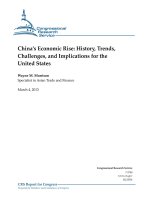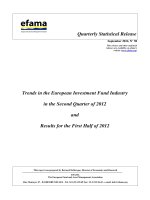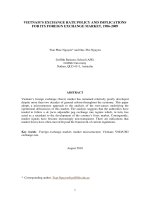China’s banking reform: Issues and prospects for the future
Bạn đang xem bản rút gọn của tài liệu. Xem và tải ngay bản đầy đủ của tài liệu tại đây (330.28 KB, 20 trang )
Restricted
1
China’s banking reform:
Is s ues and pros pects for the future
Alicia García He rrero *
Bank o f Internatio nal Se ttle me nts
Repre s e ntative Office fo r As ia and the Pac ific
CASS, Be ijing June 7, 2007
*Op inions are mine and no t nece s s arily tho s e o f the BIS
Restricted
2
Roadmap to the presentation
1. Why do all care for China’s financial reform?
2. An assessment of the banking reform so far
A. Restructuring of SOCBs
B. Financial liberalization
C. Regulation and supervision
3. How are banks doing?
4. Suggestions for future steps
Restricted
3
1. Why do all care for China’s financial reform?
China’s outstanding growth performance justifies optimism
And yet, such huge saving and investment ratios should yield even
higher growth
► Banking system is the pillar (over 80%) but does not
function properly: potential misallocation of resources
► But also a lot of
self-financing key (60% ) and
informal financing: risky!!
Success of ongoing bank reform key:
–
For China’s economic development
–
For the rest of the world given China’s size & interlinkages
Restricted
4
2. An assessment of the reform so far
a. Restructuring
Organized in three waves, each of them with:
Recapitalization
Disposal of non-performing loans (NPLs)
Partial privatization
Issuance of subordinated debt
Restricted
5
a. Restructuring (con’t)
Large capital injections to 3 of the 4 largest banks (state-
owned commercial banks)
–
In three waves 20-24% of 2004 GDP injected in the
banking system:
•
This amounts to over 110% of SOCBs capital
–
Not really a bail-out since
•
By and large only public-owned banks restructured
–
Howeer, different public/semi-public entities covering
the costs
•
Distribution of costs not very transparent
Restricted
6
a. Restructuring (con’t)
Even larger disposal of bad assets: NPLs transferred to Asset
Management Companies (AMC):
–
In first wave, bilateral transfer:one AMC per bank
–
Disposal of assets aiming at highest recovery value and not
speed:
•
Not much recovered: about 10% of total face value
–
Financing: 45% financed by PBC credit and 10 year bond issued
by AMCs
•
Not very high yield and doubts about payment: no explicit
government guarantee:
•
Involvement of CB could eventually constrain monetary policy
although international reserves are a big cushion!
•
Fragmentation of government bond market
Restricted
7
2. An assessment of the reform so far
b. Financial liberalization
1. Introducing market practices:
–
Reduction in reserve requirements and in their
remuneration
•
Steady reduction in liquid assets although still high
–
SOCBs given more responsibility for lending decisions
•
Some credit quotas removed
–
Private ownership: joint-stock commercial banks and city
commercial banks starting 1999
–
Also foreign more recently with WTO commitments
Restricted
8
b. Financial liberalization (con’t)
2. Liberalizing interest rates
–
first money and bond market
–
then loans
–
finally deposits but not completed:
•
Corridor of 330 bp or higher: cannot be reduced!
•
Lack of competition but helps profitability









